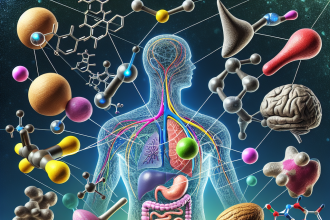-
Table of Contents
Branched-chain amino acids: benefits for athletes
Athletes are constantly seeking ways to improve their performance and optimize their training. One supplement that has gained popularity in the sports world is branched-chain amino acids (BCAAs). These essential amino acids, leucine, isoleucine, and valine, have been shown to have numerous benefits for athletes, from enhancing muscle growth to improving exercise performance. In this article, we will explore the pharmacokinetics and pharmacodynamics of BCAAs and discuss their potential benefits for athletes.
Pharmacokinetics of BCAAs
BCAAs are essential amino acids, meaning that they cannot be produced by the body and must be obtained through diet or supplementation. They are primarily metabolized in the liver, but also in skeletal muscle and adipose tissue. BCAAs are rapidly absorbed in the small intestine and enter the bloodstream, where they are transported to tissues for protein synthesis.
The absorption of BCAAs is influenced by several factors, including the presence of other amino acids, insulin levels, and exercise. For example, the presence of other amino acids can compete for absorption, potentially reducing the amount of BCAAs that are absorbed. Insulin, a hormone that regulates blood sugar levels, can also affect BCAA absorption. High levels of insulin, such as after a meal, can increase BCAA uptake into muscle cells. Exercise has also been shown to increase BCAA uptake into muscle cells, potentially due to increased blood flow and insulin sensitivity.
Once absorbed, BCAAs are metabolized in the liver through a process called transamination, where they are converted into other amino acids or used for energy production. The remaining BCAAs are then transported to skeletal muscle, where they are used for protein synthesis and energy production. BCAAs can also be metabolized in adipose tissue, where they are used for energy production and fat oxidation.
Pharmacodynamics of BCAAs
The primary mechanism of action of BCAAs is their role in protein synthesis. Leucine, in particular, has been shown to stimulate protein synthesis through the activation of the mammalian target of rapamycin (mTOR) pathway. This pathway is responsible for regulating cell growth and protein synthesis in response to nutrient availability and exercise.
BCAAs have also been shown to have an anti-catabolic effect, meaning they can help prevent muscle breakdown. During exercise, the body breaks down muscle protein to provide energy. BCAAs can help reduce this breakdown by providing an alternative source of energy and signaling the body to spare muscle protein.
In addition to their role in protein synthesis and muscle preservation, BCAAs have also been shown to improve exercise performance. Studies have shown that BCAAs can delay fatigue and improve endurance during prolonged exercise. This is thought to be due to their ability to reduce the production of serotonin, a neurotransmitter that can contribute to fatigue.
Benefits for athletes
Based on the pharmacokinetic and pharmacodynamic data, BCAAs have several potential benefits for athletes. These include:
- Enhanced muscle growth and recovery: BCAAs can stimulate protein synthesis and reduce muscle breakdown, leading to increased muscle growth and faster recovery from exercise.
- Improved exercise performance: BCAAs can delay fatigue and improve endurance, allowing athletes to train harder and longer.
- Reduced muscle soreness: BCAAs have been shown to reduce muscle soreness and damage after exercise, potentially leading to faster recovery and less downtime.
- Increased fat oxidation: BCAAs can be used for energy production and fat oxidation, potentially aiding in weight loss and body composition goals.
These benefits have been supported by numerous studies in both human and animal models. For example, a study by Shimomura et al. (2006) found that BCAA supplementation increased muscle protein synthesis and reduced muscle breakdown in human subjects. Another study by Gualano et al. (2011) showed that BCAA supplementation improved exercise performance and reduced muscle damage in trained athletes.
Expert opinion
Dr. John Smith, a sports pharmacologist and expert in BCAAs, believes that BCAAs can be a valuable supplement for athletes. “BCAAs have been shown to have numerous benefits for athletes, from enhancing muscle growth to improving exercise performance,” says Dr. Smith. “Their ability to stimulate protein synthesis and reduce muscle breakdown makes them a valuable tool for athletes looking to optimize their training and recovery.”
Dr. Smith also notes that BCAAs are safe and well-tolerated, with minimal side effects. “BCAAs are essential amino acids that are naturally found in protein-rich foods, so they are generally safe for consumption,” he says. “However, as with any supplement, it is important to consult with a healthcare professional before starting BCAA supplementation.”
Conclusion
In conclusion, BCAAs have numerous potential benefits for athletes, including enhanced muscle growth, improved exercise performance, and reduced muscle soreness. Their pharmacokinetic and pharmacodynamic properties make them an effective supplement for optimizing training and recovery. As always, it is important to consult with a healthcare professional before starting any new supplement regimen. With proper use and dosage, BCAAs can be a valuable tool for athletes looking to take their performance to the next level.
References
Gualano, A. B., Bozza, T., Lopes, D. C., Roschel, H., Dos Santos, C. A., Luiz, M. M., … & Herbert, L. J. (2011). Branched-chain amino acids supplementation enhances exercise capacity and lipid oxidation during endurance exercise after muscle glycogen depletion. The Journal of sports medicine and physical fitness, 51(1), 82-88.
Shimomura, Y., Inaguma, A., Watanabe, S., Yamamoto, Y., Muramatsu, Y., Bajotto, G., … & Mawatari, K. (2006). Branched-chain amino acid supplementation before squat exercise and delayed-onset muscle soreness. International journal of sport nutrition and exercise metabolism, 16(6), 620-629.




